GUIDE TO HELP YOU LAND YOUR DREAM JOB. LEARN EASY TO FOLLOW EXPERT TIPS ON: ✓ HOW TO WRITE A RESUME ✓ HOW TO WRITE A COVER LETTER ✓ STAND OUT FROM THE PACK ✓ ATTENDING INTERVIEWS ✓ GETTING READY FOR AN INTERVIEW ✓ TRICKY QUESTIONS IN AN INTERVIEW www.careersforcarers.com.au 1
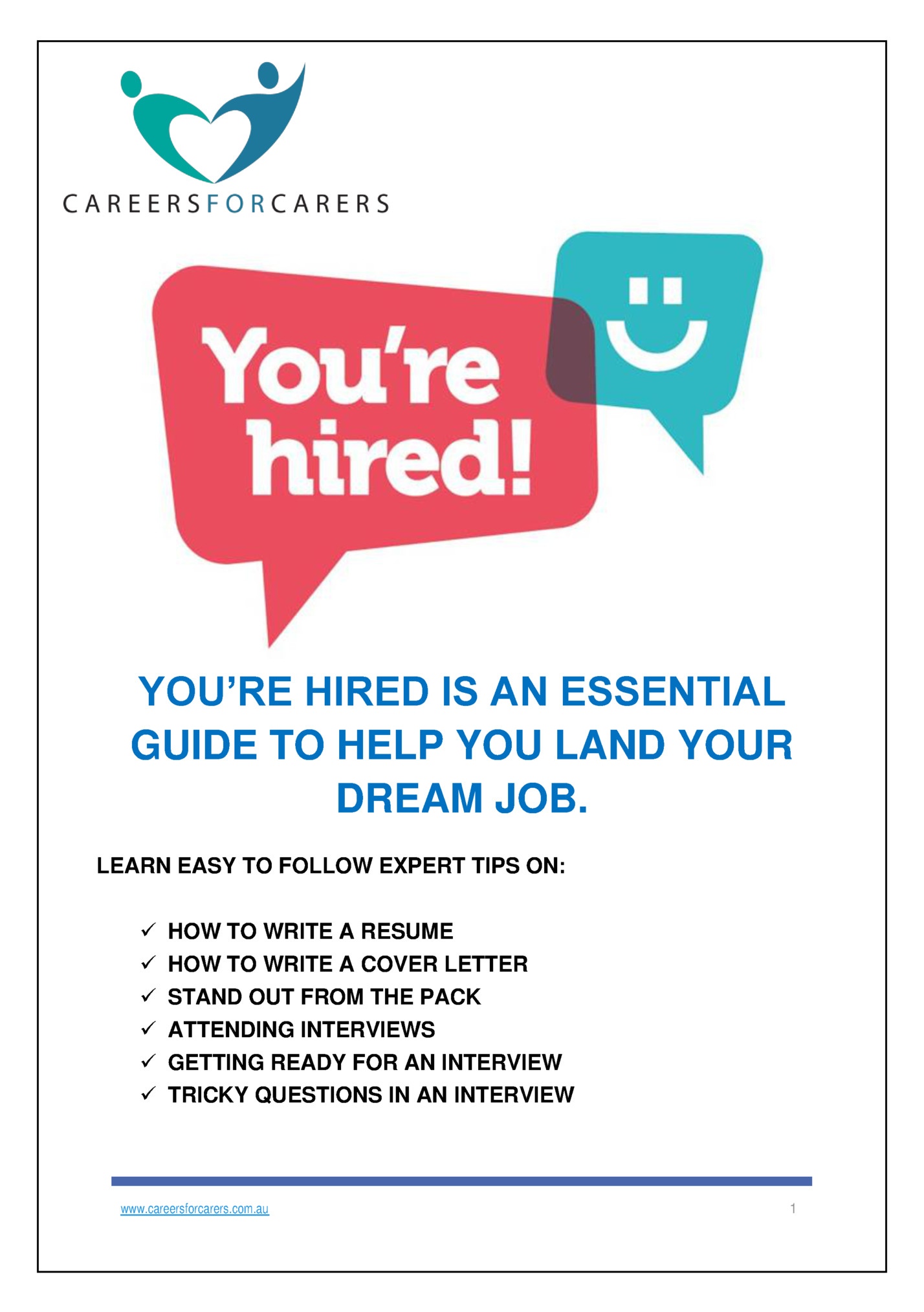
2
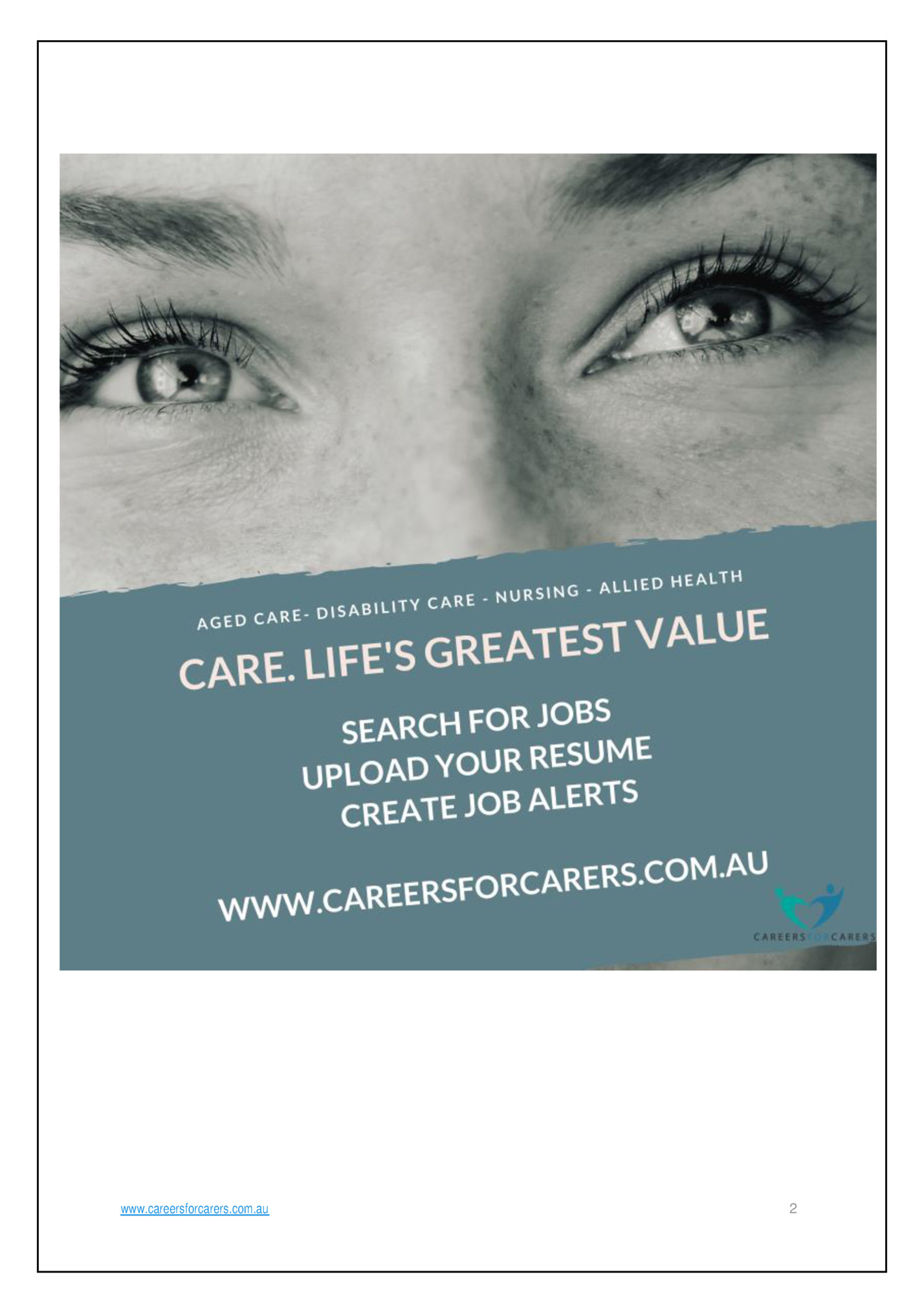
Applying for that job is the next challenge. These pages will help you work out what you need to do - and how to do it - once you've found the job you want. This guide has information, tips and advice on job applications, including how to write cover letters and put together a resume. There is also some great information on how to stand out from the pack and what to do once you have landed a job interview. The information here has been designed to help you put together the best job application possible, so check it out and GOOD LUCK! © State of Victoria. This information originally appeared on Youth Central (www.youthcentral.vic.gov.au). www.careersforcarers.com.au 3
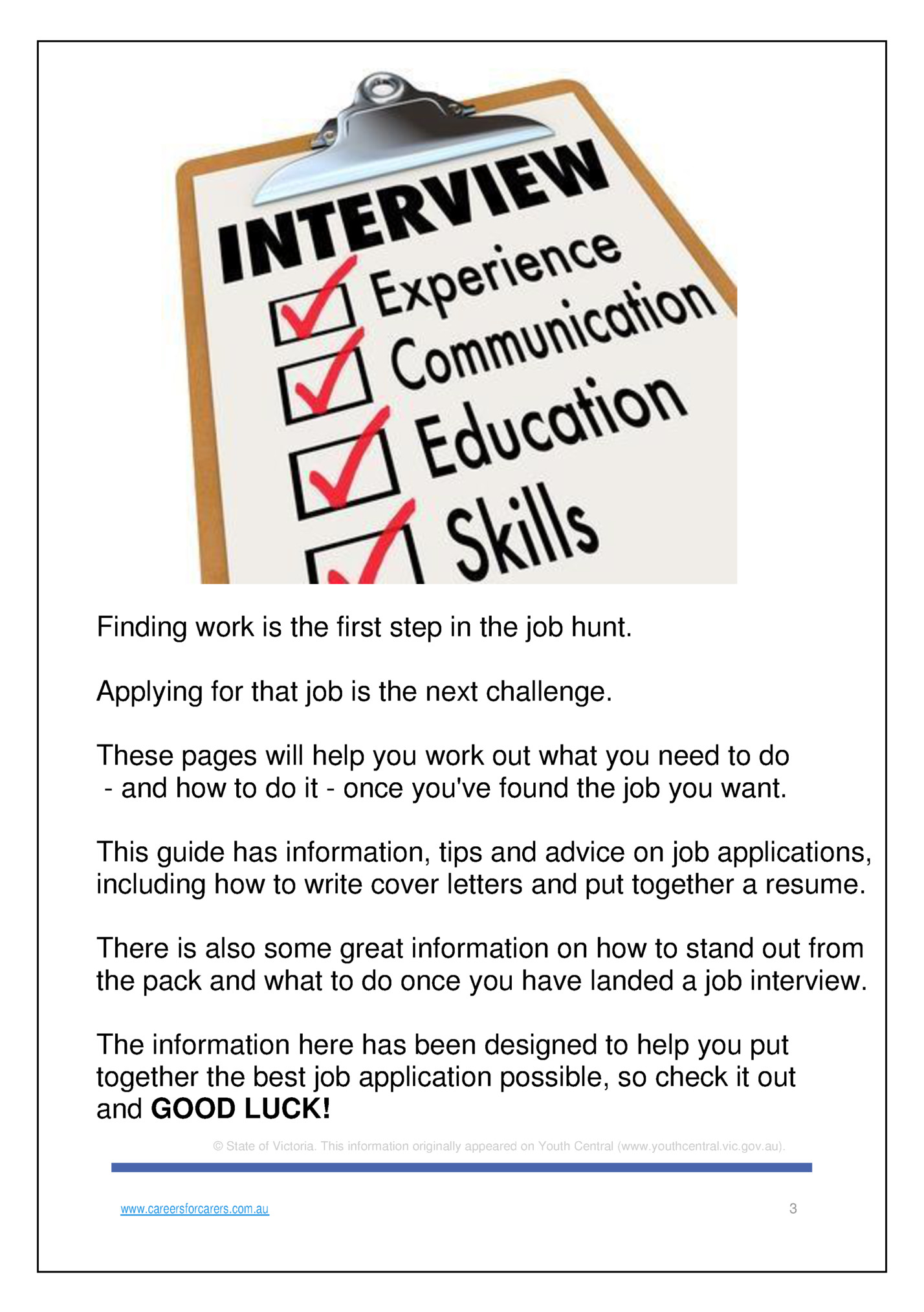
CONTENTS HOW TO WRITE A RESUME ..................................................................................... 6 The purpose of a resume ................................................................................................................. 6 How long should my resume be? .................................................................................................... 6 How should I order my resume? ..................................................................................................... 7 Do I need to change my resume for each application?................................................................. 7 How to tailor your resume ................................................................................................................ 7 What your resume should include .................................................................................................. 7 Contact details............................................................................................................................... 7 Opening statement ........................................................................................................................ 8 Key skills & strengths ................................................................................................................... 8 Personal attributes ........................................................................................................................ 8 Educational history ....................................................................................................................... 9 Employment history ...................................................................................................................... 9 References/referees ...................................................................................................................... 9 Testimonials .................................................................................................................................. 9 Keywords ....................................................................................................................................... 9 What NOT to put on your resume .................................................................................................. 10 Private information ..................................................................................................................... 10 Typos or factual errors ............................................................................................................... 10 Images and graphics .................................................................................................................. 11 Content in headers ...................................................................................................................... 11 Fancy formatting ......................................................................................................................... 11 Information in tables ................................................................................................................... 11 PDF versions of your resume .................................................................................................... 11 Reviewing your resume .................................................................................................................. 11 HOW TO WRITE A COVER LETTER ....................................................................... 12 The purpose of a cover letter ......................................................................................................... 12 How long should a Cover letter be? .............................................................................................. 12 Customise your cover letter .......................................................................................................... 12 1. Find out who to address it to ................................................................................................. 13 2. Find out more about the job................................................................................................... 13 3. Find out more about the company ........................................................................................ 13 www.careersforcarers.com.au 4

Your name and contact details .................................................................................................. 13 Their name and contact details ................................................................................................. 14 The name of the job you’re going for ........................................................................................ 14 A list of your relevant skills ....................................................................................................... 14 A summary of why you’re right for the job ............................................................................... 14 Speak their language .................................................................................................................. 13 Ask them to check out your resume & contact you ................................................................ 14 What NOT to include in a cover letter ........................................................................................... 15 Typos or factual errors ............................................................................................................... 15 Your entire resume ..................................................................................................................... 15 Using “I” too much ..................................................................................................................... 15 Don’t mention your other job applications ............................................................................... 15 Cover letters for when there’s no job advertised ........................................................................ 15 Email cover letters .......................................................................................................................... 16 STAND OUT FROM THE PACK .............................................................................. 17 Get past the first round .................................................................................................................. 17 Do your research ............................................................................................................................. 17 Tailor Your Resume and Cover Letter .......................................................................................... 18 Avoid Gimmicks .............................................................................................................................. 18 Stand Out in Your Interview ........................................................................................................... 18 Get Feedback ................................................................................................................................... 18 ATTENDING INTERVIEWS ..................................................................................... 19 What do employers look for?......................................................................................................... 19 What questions will they ask? ....................................................................................................... 19 What questions should I ask? ....................................................................................................... 20 Second interviews ........................................................................................................................... 20 GETTING READY FOR AN INTERVIEW ................................................................. 21 Research .......................................................................................................................................... 21 Prepare for interview questions .................................................................................................... 21 What should I wear? ....................................................................................................................... 21 TRICKY QUESTIONS IN A JOB INTERVIEW.......................................................... 22 “Why did you leave your last job?” .............................................................................................. 22 “Why have you had so many jobs?” ............................................................................................. 22 “Why were you out of work for so long?” .................................................................................... 22 Don’t Freak Out ............................................................................................................................... 23 www.careersforcarers.com.au 5
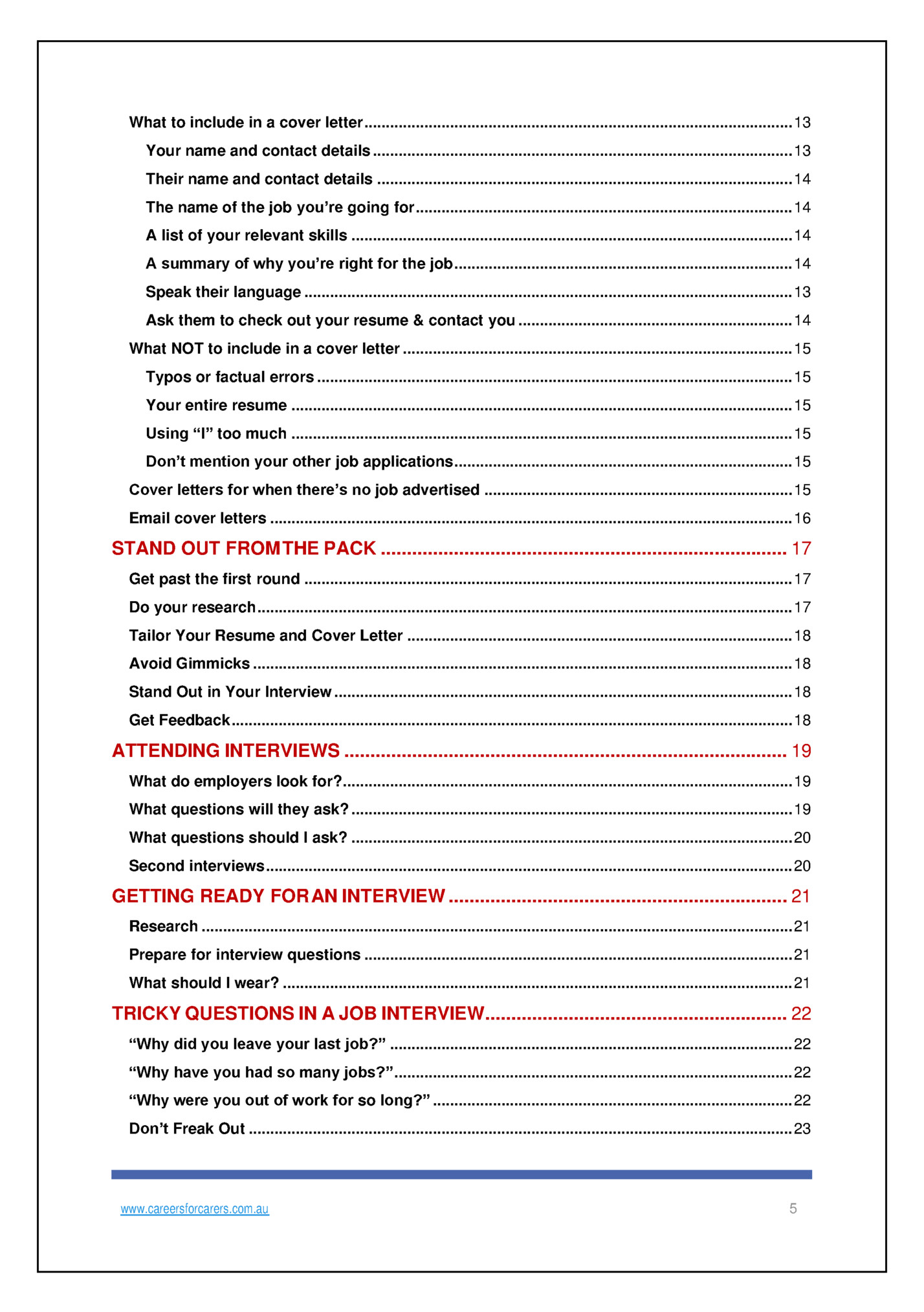
Your resume (sometimes called your “CV”) is your most important tool when applying for a job. It doesn’t matter how qualified you are, or how much experience you have – if your resume is poorly presented or badly written, you’re going to have trouble getting the job you want – or even an interview. Taking the time to work on your resume is really important. The information on this page offers some tips and advice on how to make your resume the best it can be. Topics on this page include: The purpose of a resume How long your resume should be The order of information on your resume Changing your resume for each application What your resume should include What your resume should NOT include Reviewing your resume Resume templates THE PURPOSE OF A RESUME Your resume is a marketing tool. It needs to demonstrate: • That you are employable How you meet the job and the organisation’s requirements That you have the right qualifications and education That you have the right experience and skills That you have the right level of professionalism for the job HOW LONG SHOULD MY RESUME BE? There is no set length for a resume. A resume varies in length depending on your experience and education. If you haven’t worked much before, one or two pages is best, but three pages is okay if you’ve got a lot of study and work behind you. Make sure you don’t pad out your resume. If your resume is only one page, as long as it’s wellpresented it might get better results than a two-page resume full of unnecessary information. www.careersforcarers.com.au 6

Generally, it’s always good to present the information on your resume in this order: 1. 2. 3. 4. 5. 6. 7. 8. Contact details Opening statement List of key skills List of technical/software skills Personal attributes/career overview Educational qualifications Employment history/volunteering/work placements References/referees Not everything in this list must appear on your resume every time, and the order can change from application to application. The most important thing is to get the most useful information across first. For example, if your education history is not specifically related to the job, put it toward the end of your resume, behind the information that is related to the job. DO I NEED TO CHANGE MY RESUME FOR EACH APPLICATION? You need to tailor your resume to every job application so that it responds to the specific requirements of the job you’re applying for. You might not need to change much, but you do need to make sure your opening statement, your key skills and your personal attributes all respond to the needs of the role, based on the job ad (if there was one) and the research you’ve done into the job. You should also tailor your resume to show how your work experience specifically meets the needs of the job you’re applying for. HOW TO TAILOR YOUR RESUME Ways that you can tailor your resume include: Using your opening statement to link your experience and education to the organisation and the requirements of the job Listing your most relevant key skills first Including examples of achievements that meet the advertised requirements of the job Including specifically relevant key words and phrases throughout your resume WHAT YOUR RESUME SHOULD INCLUDE There are a number of things that every resume should have on it. CONTACT DETAILS Make sure you include your name, email address and a contact phone number on your resume. You don’t have to include your home address, although there might be some situations when doing so would be a good idea. www.careersforcarers.com.au 7
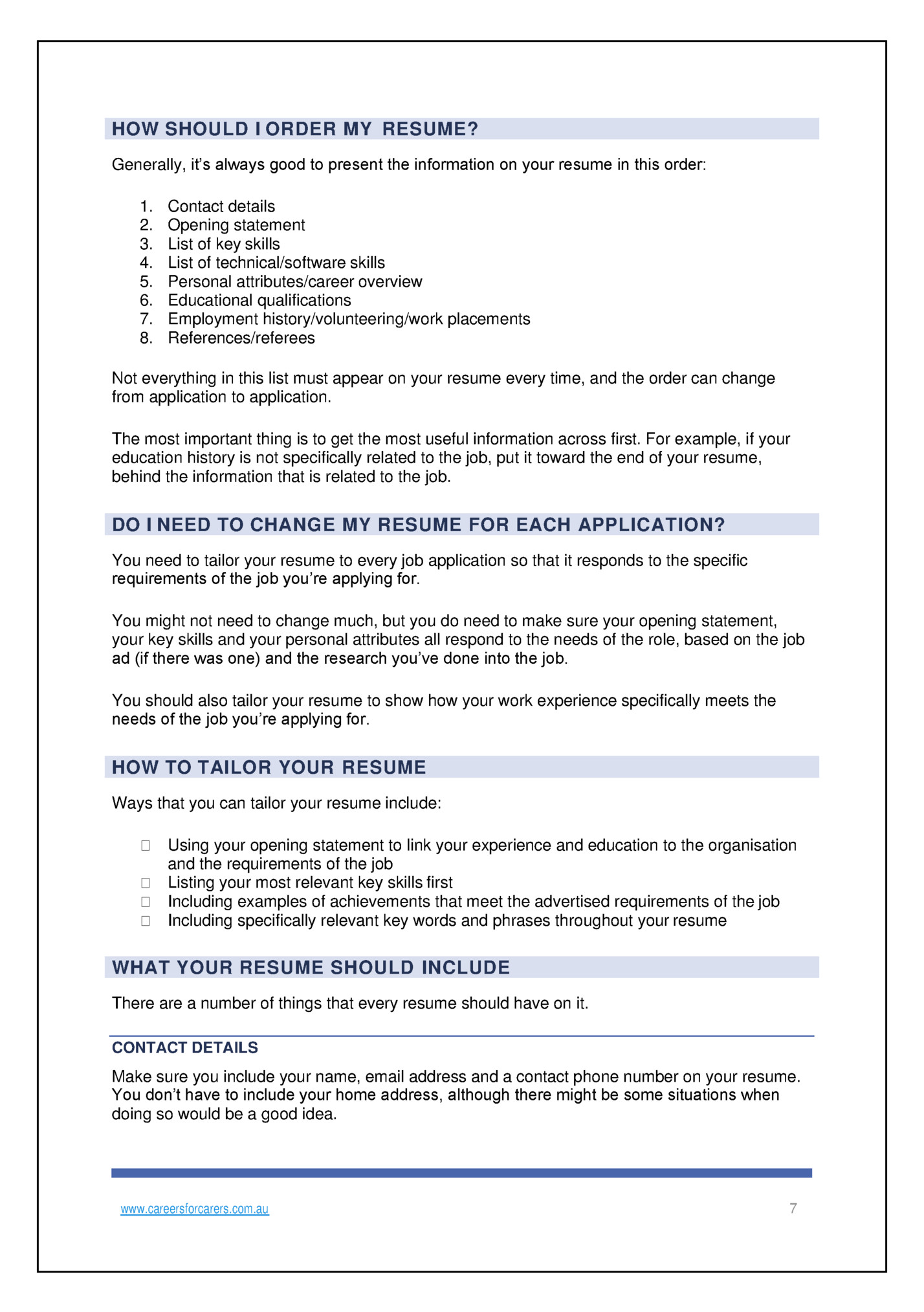
has difficulty reading information in headers or footers, so it’s a good idea to avoid headers altogether. You can put your contact details in the footer of your resume, but if you do, you must make sure they’re also in the main body of the document. OPENING STATEMENT An opening statement is a summary of who you are, where you’ve studied and/or worked, and what you bring to the job. It should be about six lines long and written in first person without the personal reference (i.e., don’t say “I did this” – say “Did this” instead). Your opening statement should start with one sentence about who you are and what you bring to the job, then describe the skills and attributes you have that suit you to the job. KEY SKILLS & STRENGTHS Your resume should include a list of between 10 and 15 skills that link your experience to the job you’re applying for. If the job you’re applying for was advertised, either the ad or the position description may provide a list of skills and experiences that are essential for doing the job. It may also provide a list of “desirable” skills and experience. Your list of key skills & strengths needs to respond to all of the items on the “essential” list and as many items as possible on the “desirable” list. When putting together this list, think of things you’ve done or learned to do as part of: • • • Jobs you’ve had Your studies Any work placements you’ve done Any volunteering you’ve done PERSON AL ATTRIBUTES If you haven’t got much work experience, a list of personal attributes can be another way to demonstrate that you’re the right person for the job. Things you could include in this section might include ways you can demonstrate that you are reliable, honest, trustworthy or quick to learn new things. You can include between three to five personal attributes, but make sure you don’t include them instead of your key skills www.careersforcarers.com.au 8
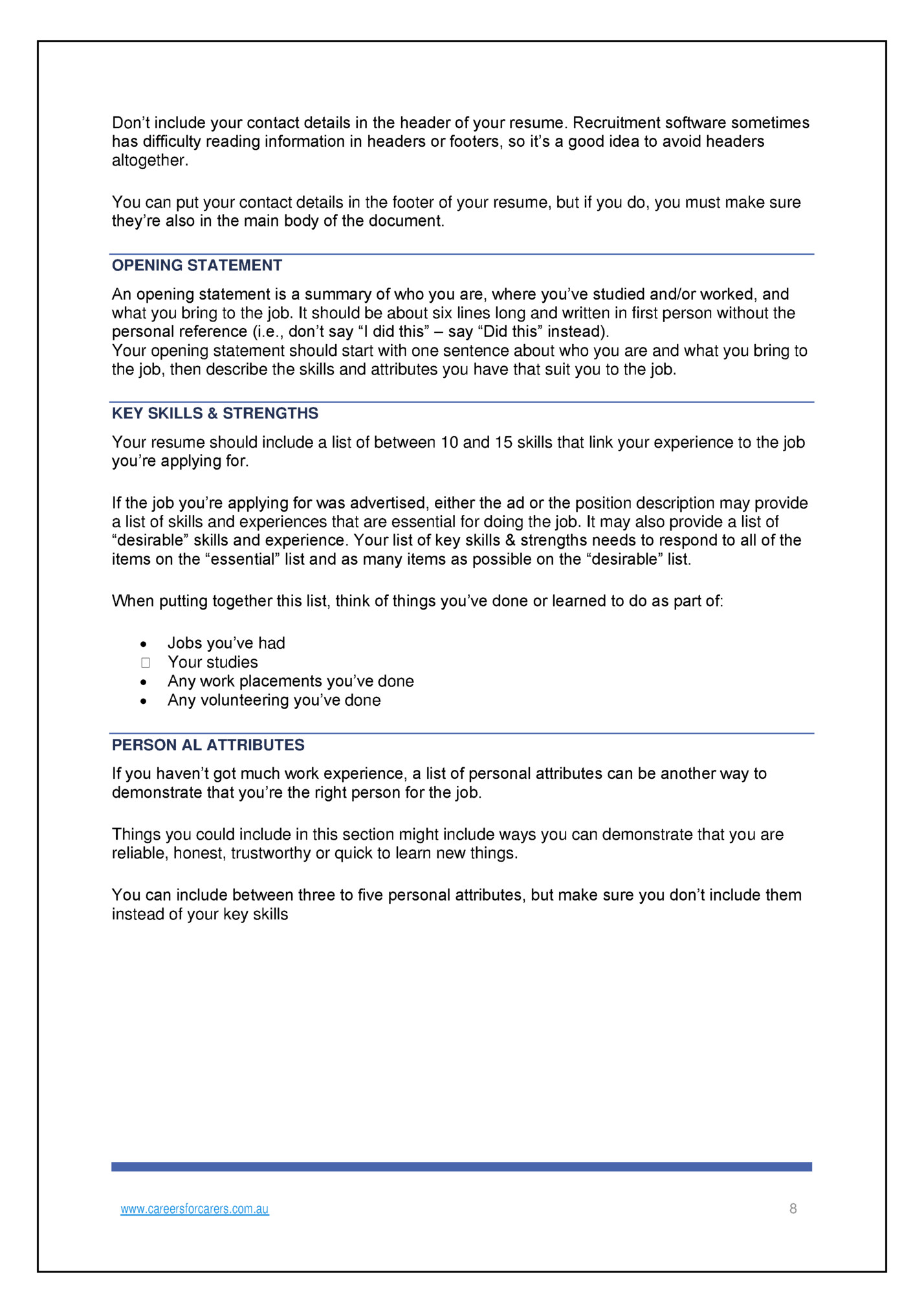
Your educational history only needs to show your highest level of education. You don’t need to include your results, unless showing them proves how well you’re suited to the job. If you can, you should also include a few bullet points listing your academic achievements (e.g., school or class captaincies, awards you’ve won, or groups you’ve been part of). EMPLOYMENT HISTORY When providing your employment history, start with the your most recent job and go backwards from there. Give the position title and the dates you worked there. If you haven’t had a job before, you can use other things to demonstrate your experience, including: • • • Work experience you’ve done through school Work placements or internships that you’ve done through university or TAFE Volunteer work you’ve done For each job provide a list of the things that you achieved while in that job, and the significant contributions you made to the organisation. Make sure that these achievements and contributions match the key skills and strengths listed earlier on your resume. REFERENCES/REFEREES Your resume should list two people who can positively recommend you as an employee. Ideally your references will be people that you have worked with before. Provide their name, their position title, and a way that they can be contacted. Ask their permission before including them on your resume. TESTIMONIALS A testimonial is another good way to prove that your skill and experience is what the employer is looking for. Getting a testimonial can be as easy as asking a colleague, teacher or previous employer to write a couple of sentences about you. Ideally the people you get testimonials from should also be included in your references. You can include any testimonials you get as part of your educational history or your employment/volunteering/work placement history. Usually it’s enough to include one or two testimonials in your resume. Any more than two is probably too many. KEYWORDS A lot of recruitment agencies use software that scans applications for key words and phrases. Applications that don’t use the right keywords tend to be automatically rejected. Key words and phrases that this software looks for can include the names of: Skills Jobs Activities Qualifications www.careersforcarers.com.au 9
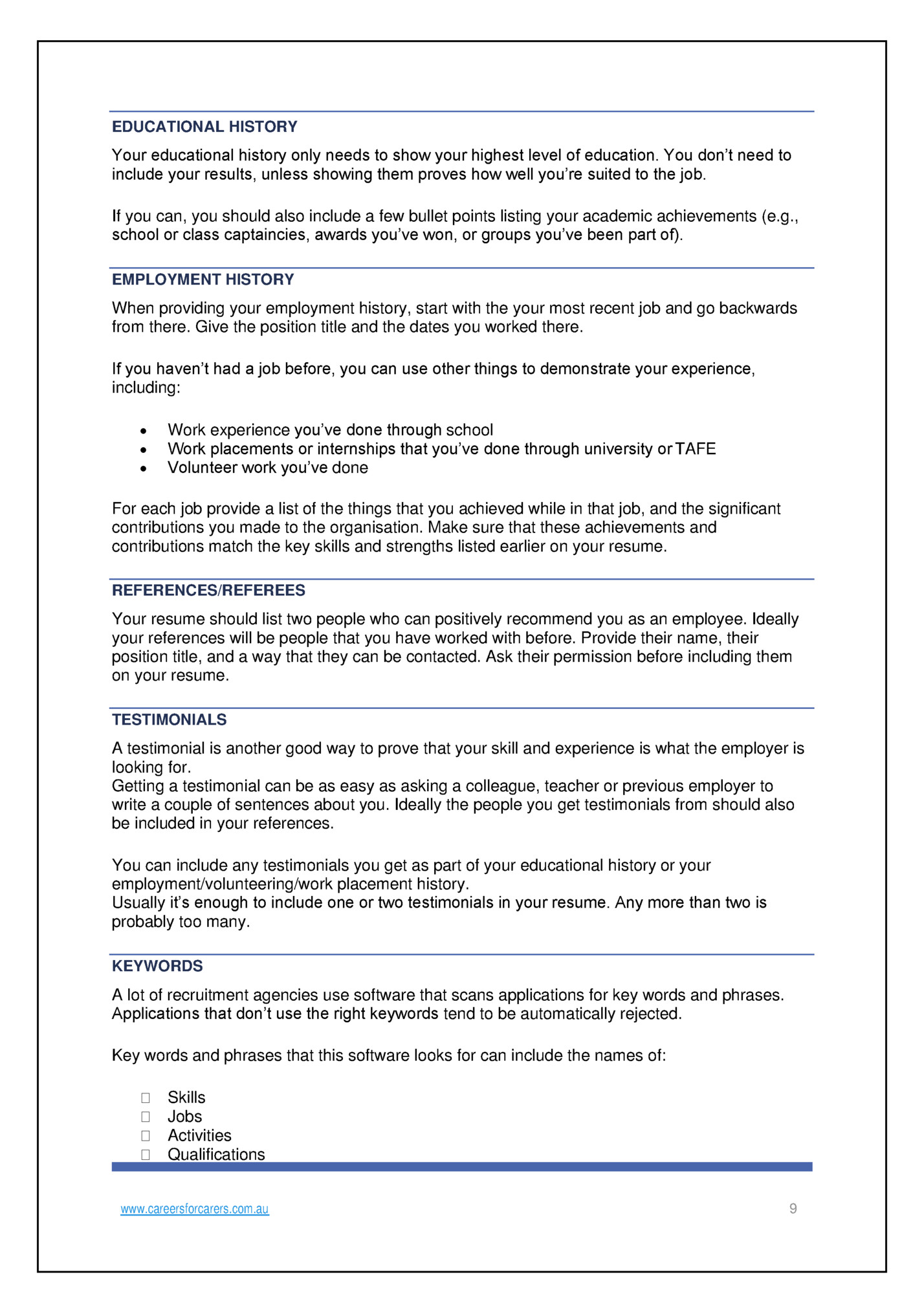
Fleepit Digital © 2021